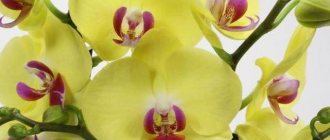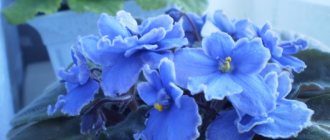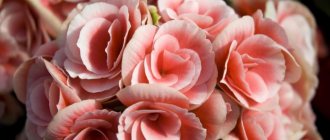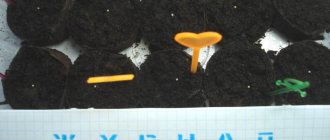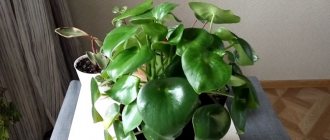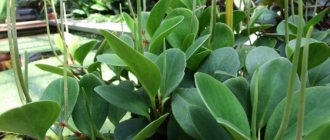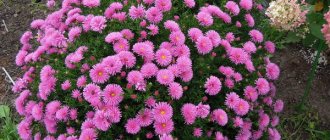Popularly, hoya is simply called “wax ivy.” This vine was given this name because of its dense, fleshy foliage, which looks as if it is drenched in wax. In the wild, hoya grows on rocks. It comes from Asia and is common in China and India. Some types of wax ivy also grow in Australia.
Growing hoya is not particularly difficult, but it is a heat-loving flower; its development slows down in cool rooms. One more “but”: if there are children and pets in the house who like to chew leaves, this flower cannot be grown. This will cause severe poisoning in children, and small or weakened pets may die.
What is hoya, the care and cultivation of which so frighten many gardeners?
How to select and prepare soil?
For hoya, a neutral or slightly acidic substrate is preferable. Many gardeners use ordinary garden soil. You can prepare a special mixture for growing hoya.
Based on leaf soil
- Leaf soil - 1 tsp.
- Humus – 1 hour.
- Clay-turf soil – 2 hours.
- Drainage is required.
Based on turf land
- Turf soil – 2 hours.
- Greenhouse land – 1 hour.
- Leaf part - 1 tsp.
Another option
Clay-turf soil - 2 hours.- Leaf soil - 1 tsp.
- Sand – 1 hour.
- Peat – 1 hour.
- Pieces of charcoal.
- Drainage layer.
The choice of soil for hoya depends primarily on the type of plant . Thus, one type of haworthia can live well in ordinary garden soil, while another variety requires special soil.
Therefore, before replanting a certain type of Hoya, you should study in detail what kind of soil and under what conditions the flower lives in the wild.
Botanical description
In nature, an adult plant can reach 10 meters in length. Leafless young shoots have a violet-brown tint, but as they grow older, when leaves and aerial roots begin to appear on them, the shoots turn green and become woody over time. Fleshy and shiny at a young age, the leaves gradually become dull; they are oval in shape and pointed towards the top. The leaf size is 5-8 cm in length and 3-5 cm in width. Hoya flowers, white or pinkish, bisexual, star-shaped, are collected in umbrellas located on stem branches. The diameter of each flower is 1-2 cm, except for the flowers of Hoya imperialis, which reach 8 cm in diameter. In the center of the corolla of the flower there is a five-membered crown, rising above the petals. The flowers are fragrant and produce nectar that attracts insects.
In culture, hoya can bloom only in brightly lit windows; in addition, the plant has become so domesticated that it no longer needs to be in the fresh air even in the warm season. Indoor hoya is divided into three categories:
- ampelous hoya, or hanging;
- hoya ivy wrapping around the support;
- erect hoya forming a bush.
Reproduction methods
Seeds
Pros and cons of the method
Hoya usually does not propagate by seeds at home (read about whether it is possible to keep hoya at home and why it is dangerous). Hybrid varieties do not produce viable seeds. Sowing is usually done in special conditions, in humid greenhouses.
How to select and prepare seeds?
The seeds usually ripen after flowering and are found in pods . To sow, they must be well dried.
Important! Use seeds within a year; hoya has a short seed viability.
How to plant - step by step instructions
The procedure for sowing and germinating seeds is long and labor-intensive:
- Burlap or artificial fibers are added to the sand and peat substrate.
- The seeds begin to germinate within a week.
- Seedlings are kept at a temperature of at least 20 – 22°C.
- Additional illumination of seedlings and regular watering in small doses are required.
- Seedlings are grown for up to 2.5 - 3 months.
- When 3–4 leaves appear, the seedlings are transplanted into small pots.
To prevent rot of seedlings, spraying with copper-containing preparations is necessary.
Cuttings
Advantages and disadvantages
Hoya propagation by cuttings is the most reliable and easiest way to grow. It is better to carry out cuttings in the spring , when transplanting young flowers, cutting off long viable shoots.
Preparatory stage
Cuttings are taken only from healthy, undamaged stems.
Cut diagonally 6 - 7 cm in length. Each planting cutting should have 2 - 3 pairs of leaves and nodes . The cut is made below the nodules; it is in the internodes that the roots develop.
Before planting, the cuttings are dipped in a solution of root growth stimulator for 1 - 2 hours.
You can root cuttings in water or a special substrate:
- Drainage layer.
- Sand – 1 hour.
- Peat – 2 hours.
How to root - procedure
The procedure for cutting hoya is simple and is carried out sequentially:
- The pot is wrapped in foil or thick cloth.
- Cuttings are carried out without light entering the substrate.
- The treated cuttings are lowered into the substrate by 1–2 cm.
- The pot is placed in a warm place – 21 – 23°C.
- For better rooting, the cuttings are covered with film or foil.
- The greenhouse is ventilated daily, after 10 days the shelter is removed.
- After 2 – 2.5 weeks, roots appear.
Attention! Roots should not be allowed to grow, this makes replanting into the ground difficult, the root shoots are brittle, and the flower may take a long time to take root and become sick.
Small pots for planting cuttings are used - 9 - 10 cm in diameter. You can plant 2 - 3 cuttings in one pot .
Substrate for replanting hoya after rooting cuttings:
- Leaf soil - 2 hours.
- Turf soil – 1 hour.
- Sand – 1 hour.
- Humus – 0.5 tsp.
- Mineral fertilizers.
- Drainage.
It is also easy to grow hoya using stem layering:
- A shallow cut is made on a long shoot, the cut site is covered with moss or sprinkled with substrate, secured, and wrapped with film.
- After the roots appear, the shoot is cut off and planted in a separate pot.
Video about rooting hoya:
Leaf
Pros and cons of the method
It is almost impossible to propagate hoya from leaves . The leaf must be planted in light soil, where it will take root well.
However, flower growers note that leaves planted in the ground take root well and quickly, but do not grow or develop. In other words, an adult, beautiful flower will never grow from a leaf.
This method of growing hoya is not practical and is not used by gardeners at home.
Preliminary stage
The rooting process is lengthy; for the effectiveness of the method, it is important to use leaves only of natural varieties growing in the natural conditions of the tropics.
How to reproduce - algorithm of actions
Hoya propagation scheme by leaves:
- The sections are treated with a root stimulator.
- It is important to preserve the petiole of the leaf.
- The leaves are planted in a special substrate at an angle of 45°.
- Within a week, a new shoot appears.
The root hormone - heteroauxin - is applied with a pipette to the base of the leaf.
Preparation of cuttings
For a cut branch, you must immediately make an oblique cut under the lower bud and remove the leaf. If there is milky juice (from ficuses), be sure to hold it under running water until the juice is released. Dip the lower part of the cutting into Kornevin and immerse vertically in a glass with substrate up to the next leaf so that the second bud from the bottom is at the level of the substrate. We must try to ensure that the stalk sits tightly in the soil and does not dangle; to do this, I do not cut off the second leaf from the bottom, but slightly deepen its petiole into the substrate. The cutting must have at least one or two more buds, from which the future plant will develop. Rubber-bearing ficus, for example, can be propagated by a piece of stem with only one bud, but such a cutting will have less chance of producing a new plant than a longer one. In small-leaved cuttings, the number of buds inside the substrate and on top will be greater. Sometimes it is recommended to wound the stem of the cutting (in citrus fruits, hibiscus). This is done with a clean needle - the bark of that part of the cutting that will go underground is slightly scratched.
Photo
In the photo below you can see what wax ivy seeds look like:
And these are Hoya cuttings:
Features of Hoya
Hoya is an evergreen, beautifully flowering vine. When grown indoors, its length reaches no more than 5–6 m. There are no leaves on young shoots, and they themselves are colored brown-violet. Over time, young leaf plates grow on them, as well as aerial roots, then they change their color to green and after a certain time become lignified. The leathery leaf blades are moderately fleshy, their surface has a coating that looks like wax, and there are small gray inclusions on it. The size of the foliage depends on the type of hoya, as does its color, and it can be painted in various shades of green. Young foliage is glossy, but over time it becomes matte. The shape of the leaf blades can be oval, ovoid or heart-shaped. The axillary inflorescences are leathery and fleshy. Umbrella-shaped inflorescences consist of flowers, of which there can be about 50 pieces. The shape of the flowers varies, but they all have 5 rounded petals. The diameter of the flowers reaches from 10 to 20 mm, but in the Hoya Imperial species their diameter is 80 mm. In the middle of the corolla of the flower there is a five-membered crown that rises above the petals. Externally, the flowers look velvety; they can be colored brown, white or pale green. Each opened flower stays in the inflorescence for about 20 days. After withering, a new flower forms in place of the old one. Flowering begins in the last days of May, and the bush fades in mid-autumn. During the flowering period, hoya produces a very large amount of nectar, which is why it is classified as a honey plant. In the midst of flowering, it is simply impossible not to smell the scent of wax ivy flowers.
This plant is distinguished by its absolute harmlessness. It is not a member of the poison ivy family. Other indoor flowers grow well next to hoya. Most psychics are confident that this beautiful plant has energy that helps reduce competition and aggression in those people who are close to it. In this regard, they try to decorate offices with this flower so that the working atmosphere there is more relaxed. In rare cases, the aroma of flowers can cause headaches. For people prone to allergies, experts recommend not to touch the flowers of such ivy, because this can cause the development of dermatitis on the skin.
Hoya - wax ivy Transplantation Care
Wax ivy aftercare
Temperature
For flowering and development, Hoya requires a temperature of 20 - 25°C . An increase in temperature in summer is undesirable for the flower; the hoya will begin to hurt.
To reduce the air temperature in the summer heat, you should shade the windows, increase the air humidity - place containers of water next to the pots, spray the flower every day with a fine spray, you can wipe the leaves with a damp sponge.
In winter, the temperature drops by 4 - 5 degrees, but it is recommended to avoid sudden temperature changes. Temperatures below 14 - 16°C are unacceptable for tropical hoya .
Watering
Hoya loves moisture; the substrate should be moist, but not damp, especially in autumn and winter.
Attention! The earthen clod must not be allowed to dry out. Hoya's roots quickly die when they dry out.
Water for irrigation should only be used that has settled, soft, warm, 35 - 40°. In summer and spring, it is necessary to water abundantly, regularly , every day in small doses. On especially hot days, be sure to irrigate the bushes, wipe the leaves, removing dust from them, refreshing them and preventing diseases and infections. You can use a warm shower and bathing once every 2 weeks.
Light
Hoya prefers a bright place in the apartment, but the flower will not survive in direct sunlight for long - the leaves will begin to turn yellow.
It is better to install pots on the eastern or western part of the house. In summer, it is advisable to shade southern windows with light, light fabric. It is not recommended to immediately expose young seedlings to the sun ; the flower must gradually get used to bright light.
In winter, on the contrary, hoya may experience a lack of light and begins to shed its leaves. In this case, artificial lighting with special phyto lamps is required for 2 - 3 hours a day.
Pruning and replanting
It is recommended to replant young plants every year in spring. An adult Hoya can be replanted once every 3-4 years . The crown of the flower grows quite quickly and needs reliable support.
When replanting, it is advisable to trim long stems. They can be used for further cuttings.
After flowering, the peduncle should not be cut ; new buds form on the old peduncle.
You can graft branches when 4–5 leaves appear on them; this procedure promotes branching of the hoya.
Feeding
Hoya needs to be fertilized only in spring and summer ; the flower is not fed during the dormant period. Fertilizers are applied once every 15–20 days.
As fertilizers, it is recommended to use complex mineral fertilizers for succulents or any flowering plants.
Important! If the leaves begin to turn pale and lose their elasticity, the substrate lacks nitrogen.
Pot
During the annual transplantation of young seedlings, it is necessary to use large pots 2–3 cm in diameter.
Pots, planting containers, flowerpots, and tools should be treated with boiling water or chlorine-free disinfectants before planting.
It is important to make drainage holes in the planting containers for breathability and drainage of excess water when watering. Several seedlings can be planted in one flowerpot at a distance of 7–9 cm from each other. Hoya in a group planting looks dense, this makes the flower especially decorative.
You can read more about caring for hoya here.
Rules for taking cuttings
The preparation of planting material must begin in winter, since the formation of the root system in summer cuttings is poor. This process should be carried out as follows:
- At the end of December, select a branch from the apple tree aged 1 to 2 years, the bark of which is completely free of any damage.
- Break the process at the base and fix it in a bent position with electrical tape or adhesive tape.
- With the onset of spring, cut the branch at the break point and place it in an opaque container with warm water that has had time to settle. For this case, it is recommended to use melt water whenever possible.
- For disinfection purposes, it is advisable to dissolve 2 tablets of activated carbon in water.
- During the entire time the branch is in the vessel (usually it takes 20 days), it is necessary to periodically add fresh water.
At the end of this period, a thickening can be observed at the cut site, on which roots will subsequently begin to form. After the formation of the first shoots, it is permissible to begin the rooting process.
It is recommended to cut and prepare several shoots at once, this will increase the likelihood of obtaining planting material of the desired quality.
What to do if the flower does not take root?
- If the leaves of the hoya have lost their brightness, began to curl or dry out, you need to increase the air temperature; perhaps the hoya has begun to freeze and has stopped growing.
- When a flower gets rid of its leaves, the stems become bare, it is necessary to humidify the air (you can find out why hoya leaves fall and what other diseases and pests there are in this article). Spraying leaves, shading windows, and reducing watering will help.
- If the soil dries out for a long time, hoya can drop its buds; regular moistening of the substrate is necessary.
Hoya does not take root in a damp, churned substrate; you need to replant the flower, change the substrate, and be sure to add a drainage layer. In the absence of drainage holes and drainage, the roots and stems can rot, leading to the death of the hoya.- Hoya should not be moved during flowering; the flowers will begin to fall off.
- If young seedlings are poorly accepted and do not develop, nitrogen fertilizing is required. The root system needs fertilizers, you can feed it with any root growth hormone, you can use a urea solution in a ratio of 1 - 2 g of fertilizer per 1 liter of water.
- If the hoya does not take root, it is necessary to examine the flower and soil for the presence of fungal and pathogenic infections.
- The fungus is treated by spraying with a solution of phytosporin.
- If the hoya is affected by spider mites, the bush should be treated with any insecticides.
- Treatment with corbofos will help against scale insects, aphids, mealybugs and whiteflies. Small insects are collected by hand. The leaves are wiped with an alcohol solution.
In order to grow a healthy hoya, maintain the bright variegation of the leaves, and achieve bright, dense flowering, it is necessary to take into account the peculiarities of caring for this flower, avoid overwatering and drying out the soil, dose fertilizing, monitor the lighting and temperature of the exotic content.
Possible problems
Some problems are the most common for Hoyas:
- If the leaves of a plant suddenly begin to wrinkle , this primarily indicates that it has been overcooled. Either the water for irrigation was too cold and in large quantities, or there were already problems with the root system. Perhaps the plant simply lacks nutrients and is weakening. In this case, you need to carefully care for the plant and feed it.
- Why doesn't hoya bloom at home? What to do? How to make it bloom? This is most likely caused by a lack of light. First you need to try moving the hoya to a sunnier place. Lack of a dormant period can also cause poor flowering. If the plant was blooming before, remember if you accidentally removed the old flower stalks, because new flowers grow from them.
- If hoya leaves turn yellow , this may mean not only problems with care, but also various diseases. Yellowing of the leaves is caused by fungal diseases, scale insects or scale insects. It can also be caused by a lack of light and nutrients.
Hoya is a beautiful and amazing plant that requires attention to its person. With proper care, it will become the best decoration and will delight the eye with bright blooms.
Characteristic
Hoya Lokki belongs to the Lastovnevye family.
Description of the flower:
- stems are cylindrical, thin (2-3 mm in diameter), green;
- in young plants the shoots are erect, in adults they are drooping and therefore need support;
- leaves are oval, pointed at the end, length - 10-12 cm, smooth surface, rich green color;
- lush, umbrella-shaped inflorescences form at the tips of the branches;
- the flowers are small, two-tiered, snow-white and consist of narrow petals curved outward;
- at the top of each bud there is a five-pointed crown of purple or violet tone.
Flowering is long-lasting - begins in spring and ends at the end of summer. During this period of life, the plant loses its pleasant sweetish aroma.
